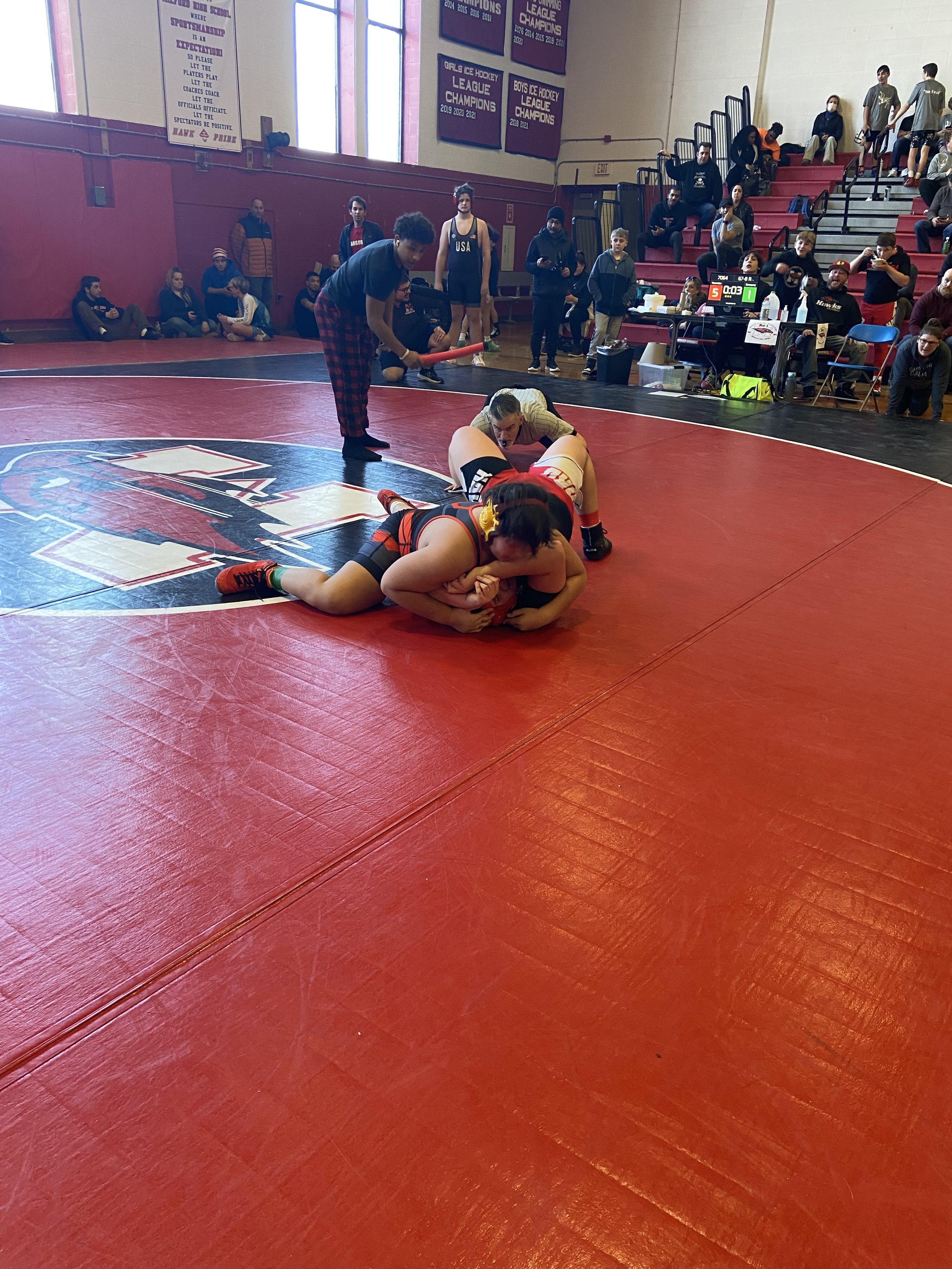Wrestling and Queen's Gambit
5 Point Thoughts
Wrestling and Queen’s Gambit
The Click
I want to address my favorite phenomenon in wrestling. The click. As a coach I talk to parents all the time about this moment. I don’t know when it will come, I’m not sure if your son/daughter knows how close they are. But, at some point it’s going to click for them. They are going to have their eyes opened to the strategy of the game. They are going to very suddenly begin to win matches. It’s visual, you see it in their body posture, in their movements and more so in their eyes. The confidence stepping on the mat and walking off the mat is a visible difference you can practically weigh on the scale. I got to see one of our athletes this weekend click. He is a 3rd grader and I’ve been working with him for 2 years now. He has loved wrestling but for quite some time, wrestling hasn’t loved him. Last year his matches went from a handshake to pins pretty quickly. Then he began defending himself, making matches last a little longer. He then began to score a couple points. This year he won a match. Then two. And his season just ended when he placed third at U10 States. So what happened? How is the jump that quick? How can he go from months ago getting pinned to placing at states?
Our community; coaches, parents and athletes, always talk about this gap when kids win and lose matches. This huge discrepancy between these talented wrestlers and everyone else. We see a score of 10-2 as an athlete gets pinned and we think about how big of a gap there is to make up. This huge talent discrepancy from one athlete to the other. But, in reality it’s a culmination of tiny little moments with small windows of opportunities that add up to each tiny victory. It’s all the small moments in wrestling. It’s the small battle of which athlete grabs the wrist first, which one flips their hips in the right direction, and which one begins to chain moves together. As kids gain more and more experience in wrestling we see them begin to understand these moments. They recognize them and can jump to the conclusion faster.
Queen’s Gambit
If you want to understand our sport you may try watching a movie like “Vision Quest” or “Win Win”. I’m a bigger fan of the latter than of Vision Quest. Vision Quest is a classic but it is a little dated and kind of weird. But that “Lunatic Fringe” comes on and it gets me everytime. The problem is you watch as Louden Swaine (played by Mathew Modine) hits big move after big move. Lat drops and standing Petersons! Unfortunately the big screen isn’t interested in wrestling looking like it truly does most of the time. Over time I’ve come to realize if you truly want to understand wrestling you should watch Queen’s Gambit. The Netflix special showcases Beth Harmon (Anya Taylor-Joy) learning and mastering the game of chess. It's a great show and helped me better understand chess and with that I believe it would help parents and athletes (maybe keep the skip button handy a few times) better understand wrestling.
I understood chess as a call and response. You do this and I do that. I plan my moves way ahead of time, trying to get 2 or 3 moves ahead. We think of wrestling much the same. One player exerting dominance like Magnus Carlson over the rest of the field. But as you begin to understand chess and how it’s played we may be even more similar to the board game than most people realize. Chess isn’t some random game. It’s not a series of random actions on the board. There are plays, called openings, and responses to those openings that players must make (I’m not an expert in chess). But chess is less about reaction in the moment as it is about being able to pull from a plethora of opportunities based on what you see. Players must study and practice every type of movement on the board based on their opening. From there they can seem to play the game 2 or 3 steps ahead. They know the movements ahead of time. It’s not random but a reaction to get to the desired result based on the opening you have selected.
Once you begin to realize that in chess there are only so many maneuvers a person can make to your opening you begin to understand how not to just win at chess, but master it. In Queen's Gambit the players start to compete in a style called speed chess. Where they are forced to make the same decisions in split seconds. This throws the gamesmanship of chess into a new direction as your speed and ability to call the movements must be accurate in a split second.
Same goes in wrestling. It is not these wild movements we make hoping to land in the right spot. We have openings too, called setups, and we execute techniques based on the expected responses from our opponents.
The gap in ability we see in wrestling isn’t a giant hole, but instead a series of small moments that culminate in an overall match. It’s a combination of knowledge in our predetermined maneuvers in each sequence.
Youth wrestling looks like chess. Beginners play at a pace that they understand. And when they don’t the maneuvers begin to overlap and they can lose control. It’s why we only teach so many moves to the youngest athletes. Try to keep it simple for them so they only go to positions they are trained in. Obviously this is sometimes thrown out the window. But, as kids practice, get more comfortable and start to see the moves they are trying to execute they begin to recognize where they are and what they are trying to do. It’s why sometimes it seems so random that your athlete can have these great days and bad days. It seems so random. But in reality it's the consistency they can get to their positions that determines their success overall.
At the higher levels in youth, high school and beyond, wrestling becomes a physical version of speed chess. Once the whistle blows an athlete must choose their opening, they grab a wrist. From here there are reactions, drag bys that turn into duck-unders that turn into chin whips and finally they end this flurry by battling for hip control and maintaining position. The kids that can play this version of speed chess have the ability to call and respond without thinking. Their maneuvers aren’t thought out on the spot, but instead they have trained their body to react to specific conditions. They aren’t thinking of moves from practice last night, but instead they are trying to get their opponent into the position they are most comfortable playing out of.
Final X as Jordan Burroughs enters the arena!
The match becomes less confusing as you begin to understand all the parts. The takedowns your athlete is attempting, the reactions they can exhibit, the top moves they want to utilize and the bottom moves they try to create space with. They become more consistent, the moves become more consistent, and the results become more consistent. In chess you want to reach a checkmate. In wrestling it's a pin. Kids understanding their best position to get a pin will ultimately get them to understand the match better. Head Snap, High Crotch, Drive Across, Half Nelson, is one way kids can get to their desired location. There are thousands of positions, moves, and reactions that happen quickly along the way that can determine where they end up. Depending on their training they may be ready for all the small battles along the way. They may be ready to overcome odds. They may have all the pieces to attack and defend.
Checkmate!
The click happens when your athlete closes the gap on the small moments. It’s not this giant result they are trying to make up but instead a series of tiny decisions. The click isn’t learning how to wrestle. It’s learning how you want to wrestle. How to get to the positions you have the advantage in. How to set up your opponent. And very suddenly you find yourself winning matches and placing in tournaments.
It’s not easy. It’s very difficult. The best wrestlers know how to get to their positions from everywhere. And adding things like strength, endurance, toughness, and speed are mental and physically trained attributes that will help you get to your positions easier. They are needed when performing at the highest levels of any age group.
Ultimately, athletes go on to accomplish great things. But watching a kid who has loved the sport finally click is one of my all time favorites!
Checkmate!






